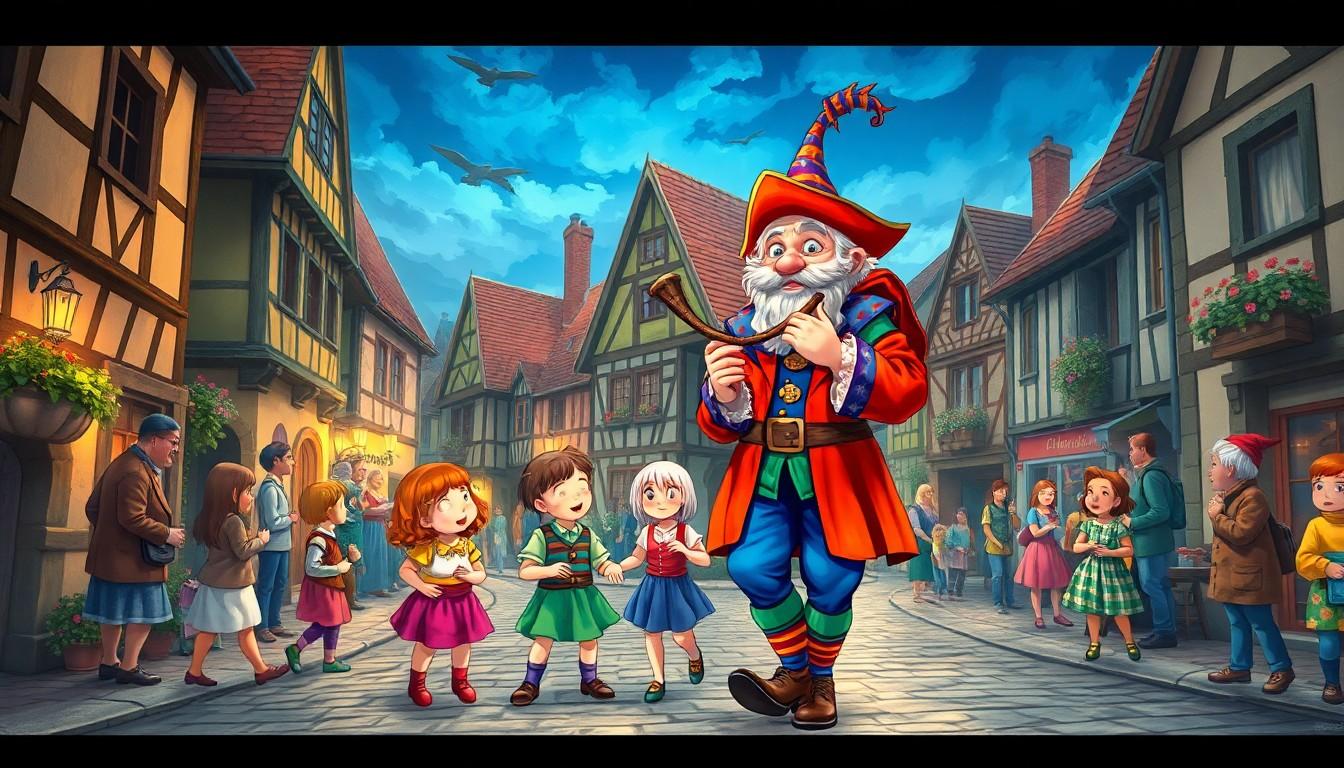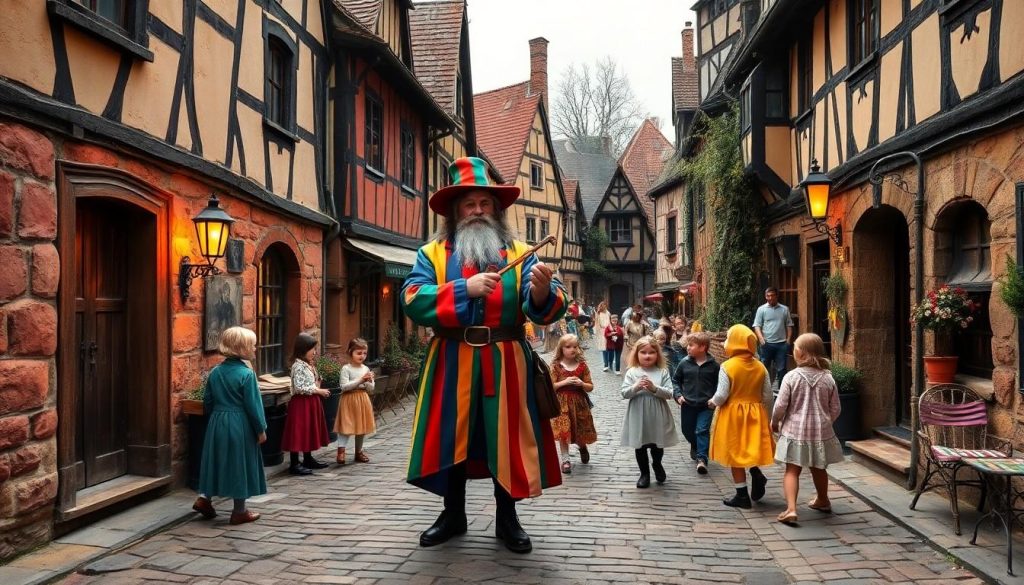The Pied Piper of Hamelin is one of the most intriguing and haunting folk tales from medieval Germany. This legendary story, dating back to the 13th century, combines historical events with folklore to create a cautionary tale about broken promises and their dire consequences.
Set in the town of Hamelin during a devastating rat infestation, a mysterious figure emerges wearing multicolored clothing and carrying a magical pipe. The tale’s enduring popularity has inspired countless adaptations in literature, film, and popular culture while raising questions about its true origins. Some historians believe it’s based on actual events where Hamelin lost many of its children, though the exact circumstances remain mysterious.
The Origins and History of the Pied Piper Tale
The Pied Piper tale originates from medieval Germany, specifically in the town of Hamelin, Lower Saxony. The legend’s earliest documented reference dates to June 26, 1284, marking a mysterious event that profoundly impacted the town’s history.
Early Written Records and Sources
The earliest physical evidence of the Pied Piper story appears in a stained-glass window at the Church of Hamelin, created around 1300. Historical records document this window’s existence through multiple accounts spanning the 14th to 17th centuries until its destruction in 1660. Two significant medieval texts preserve the tale’s early versions:
- The Latin verse in Decan Lude’s chorus book (1384)
- The Lüneburg Manuscript (1440-1450)
- Location advantage near significant trade routes
- Agricultural production centered around grain storage
- Population growth during the 13th century
- Economic importance as a regional trading hub
| Historical Timeline | Event |
|---|---|
| 1284, June 26 | Documented disappearance of 130 children |
| 1300 | Creation of commemorative church window |
| 1384 | First written record in Decan Lude’s book |
| 1440-1450 | Compilation of Lüneburg Manuscript |
The Plot and Characters of the Legend

The Pied Piper of Hamelin legend centers around the events in 1284 in Hamelin, Germany, documented through Robert Browning’s famous poem and earlier folklore. The tale unfolds through three distinct events that change the town forever.
The Rat Infestation Crisis
In 1284, Hamelin faced a devastating rat infestation that paralyzed daily life. Rats overran the town’s streets, engaged in fights with dogs, harassed women, contaminated food supplies, and attacked infants in their cribs. The town’s leadership struggled to control the vermin population as it threatened both public health and economic stability.
The Mysterious Piper’s Arrival
A peculiar figure dressed in multicolored (“pied”) clothing appeared in Hamelin, offering a solution to the town’s crisis. The piper negotiated with town officials, setting his fee at 1,000 guilders to eliminate all rats from Hamelin. Using his enchanted pipe, he successfully lured the entire rat population to the Weser River, where they drowned, fulfilling his part of the agreement.
The Children’s Disappearance
The town’s refusal to honor the agreed payment of 1,000 guilders triggered a tragic turn of events. The piper returned on June 26, 1284, while adults attended church services. Playing a different melody on his pipe, he led 130 children from their homes through the town gates. The children’s fate remains mysterious, with various accounts suggesting they vanished into a cave or mountain, never to be seen again.
Literary Interpretations Through Time

Since its medieval origins, the Pied Piper of Hamelin story has evolved through various literary interpretations. Literary scholars trace significant adaptations from the Grimm Brothers to Robert Browning, each adding unique elements to the tale.
Grimm Brothers’ Version
The Grimm Brothers included the Pied Piper tale in their collection “Deutsche Sagen” (German Legends) 1816. Their version emphasizes the dark moral consequences of breaking promises while maintaining the core narrative elements: the rat infestation, the piper’s successful intervention, the town’s betrayal, and the children’s disappearance. The Grimm Brothers preserved the medieval German setting and folkloric elements, presenting the story as a cautionary tale about honor and consequences.
Robert Browning’s Famous Poem
Robert Browning transformed the tale into a narrative poem titled “The Pied Piper of Hamelin: A Child’s Story” in 1842. The poem adds vivid details to the medieval setting, including specific descriptions of the piper’s multicolored coat and the rats’ behavior. Browning introduces memorable rhyming verses that enhance the story’s appeal:
| Element | Browning’s Addition |
|---|---|
| Piper’s Fee | 1,000 guilders specified |
| Clothing Description | “Coat half yellow, half red” |
| Time Period | July 22, 1376 |
| Number of Children | 130 children documented |
The poem expands on the character of the mayor and town council, portraying them as corrupt officials who exemplify the consequences of greed and dishonesty. Browning’s version remains one of the most widely recognized interpretations, combining entertainment with moral instruction through its rhythmic structure and detailed narrative.
Symbolism and Hidden Meanings

The Pied Piper of Hamelin tale contains multiple layers of symbolism that reflect medieval social concerns and moral values. Each element in the story carries deep symbolic significance, from the plague-bearing rats to the mysterious piper himself.
Social and Political Commentary
The story serves as a powerful critique of medieval political structures and social hierarchies:
- The rats represent corruption and societal decay in medieval towns
- The town council symbolizes the abuse of power by privileged classes
- The piper embodies an outsider figure who challenges established authority
- The broken payment agreement reflects the exploitation of the working classes
- The loss of children demonstrates the price communities pay for leadership failures
Religious and Moral Themes
The tale incorporates distinct religious symbolism and moral messaging:
- The piper’s magical pipe represents divine intervention against sin, similar to biblical purification narratives
- The rats symbolize moral corruption and spiritual degradation in Christian contexts
- The children’s innocence contrasts with the adults’ moral bankruptcy
- The cave or mountain where children disappear parallels religious concepts of judgment and consequence
- The timing of events during church services emphasizes spiritual negligence
- The colorful attire of the piper signifies supernatural or divine authority in medieval Christian imagery
- Honoring contracts and promises
- The consequences of greed
- The price of dishonesty
- Protection of innocent members of society
- The importance of community responsibility
Cultural Impact and Modern Adaptations
The Pied Piper of Hamelin has established itself as a significant cultural touchstone since its origins in 13th-century Germany. The tale’s themes of broken promises and divine retribution have inspired numerous adaptations across various media forms.
In Literature and Theater
Literary adaptations of the Pied Piper story appear in countless works spanning multiple genres. Notable examples include Johann Wolfgang von Goethe’s poem “Der Rattenfänger” (The Rat-Catcher) and Carl Zuckmayer’s 1975 play “Der Rattenfänger von Hameln.” The story’s versatility enables its transformation into children’s books, horror novels, plays, musicals, operas, ballets, and puppet shows. Each adaptation emphasizes different aspects of the tale—from moral lessons about keeping promises to darker themes of supernatural revenge.
In Film and Television
The Pied Piper narrative has captured audiences through various screen adaptations. Productions include:
- Jacques Demy’s 1972 film “The Pied Piper” starring Donovan
- The BBC’s 1982 TV movie “The Pied Piper of Hamelin”
- Animated adaptations on channels like Nickelodeon and Disney
- References in popular TV shows such as “Doctor Who” and “Once Upon a Time.”
Each adaptation brings unique interpretations while maintaining the core elements of:
- A mysterious piper figure
- A town plagued by rats
- A broken agreement
- The disappearance of children as retribution
The story’s enduring presence across different media formats demonstrates its continued relevance in exploring justice, consequences, and moral responsibility themes.
Final Words
The Pied Piper of Hamelin is one of history’s most enduring and thought-provoking tales. Its rich blend of historical events, mysterious circumstances, and moral teachings continues to captivate audiences across generations.
The story’s transformation from a medieval German folktale to a globally recognized narrative demonstrates its universal appeal and timeless themes. Whether viewed as a historical account a cautionary tale or a symbolic representation of social issues the legend maintains its power to educate and intrigue.
Modern interpretations and adaptations prove that the Pied Piper’s message about honor, responsibility, and consequences remains deeply relevant today. This haunting tale reminds us that actions have lasting repercussions and that society must protect its most vulnerable members.

